fuel PEUGEOT 5008 2016 Owners Manual
[x] Cancel search | Manufacturer: PEUGEOT, Model Year: 2016, Model line: 5008, Model: PEUGEOT 5008 2016Pages: 364, PDF Size: 12.98 MB
Page 5 of 364
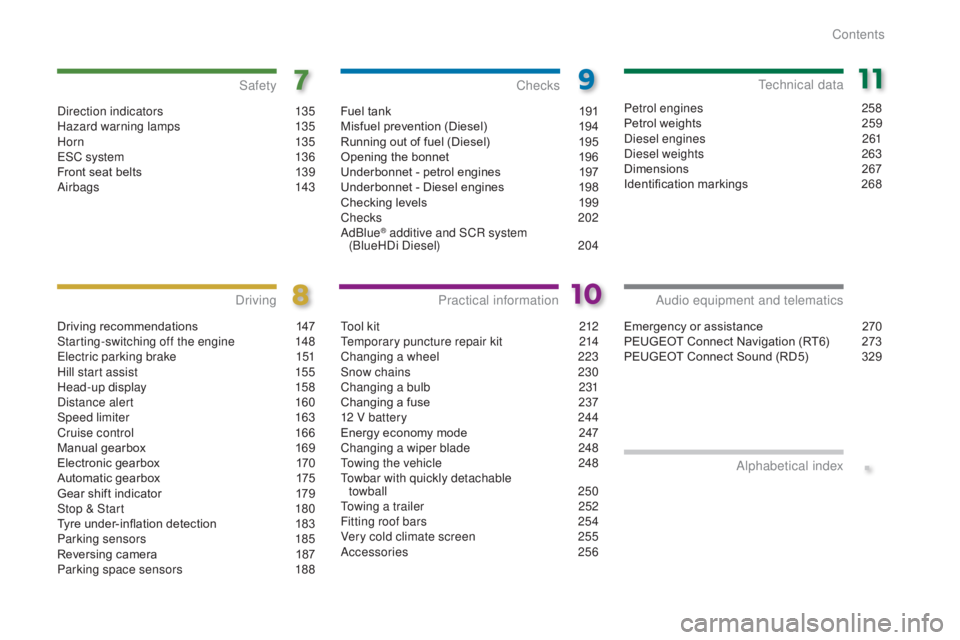
.
5008_en_Chap00a_sommaire_ed01-2015
Direction indicators 135
Hazard warning lamps 1 35
H or n
13 5
ESC system
1
36
Front seat belts
1
39
Airbags
1
43
Safety
Driving recommendations 1 47
Starting-switching off the engine 1 48
Electric parking brake
1
51
Hill start assist
1
55
Head-up display
1
58
Distance alert
1
60
Speed limiter
1
63
Cruise control
1
66
Manual gearbox
1
69
Electronic gearbox
1
70
Automatic gearbox
1
75
Gear shift indicator
1
79
Stop & Start
1
80
Tyre under-inflation detection
1
83
Parking sensors
1
85
Reversing camera
1
87
Parking space sensors
1
88
Driving
Emergency or assistance 2 70
PEUGEOT Connect Navigation (RT6) 2 73
PEUGEOT Connect Sound (RD5)
3
29
Audio equipment and telematics
Alphabetical index
Fuel tank 1 91
Misfuel prevention (Diesel) 1 94
Running out of fuel (Diesel)
1
95
Opening the bonnet
1
96
Underbonnet - petrol engines
1
97
Underbonnet - Diesel engines
1
98
Checking levels
1
99
Checks
20
2
AdBlue
® additive and SCR system
(BlueHDi Diesel) 20 4
Checks
Tool kit 2 12
Temporary puncture repair kit 2 14
Changing a wheel
2
23
Snow chains
2
30
Changing a bulb
2
31
Changing a fuse
2
37
12 V battery
2
44
Energy economy mode
2
47
Changing a wiper blade
2
48
Towing the vehicle
2
48
Towbar with quickly detachable towball
250
Towing a trailer
2
52
Fitting roof bars
2
54
Very cold climate screen
2
55
Accessories
2
56
Practical information
Petrol engines 2 58
Petrol weights 2 59
Diesel engines
2
61
Diesel weights
26
3
Dimensions
2
67
Identification markings
2
68
Technical data
Contents
Page 6 of 364
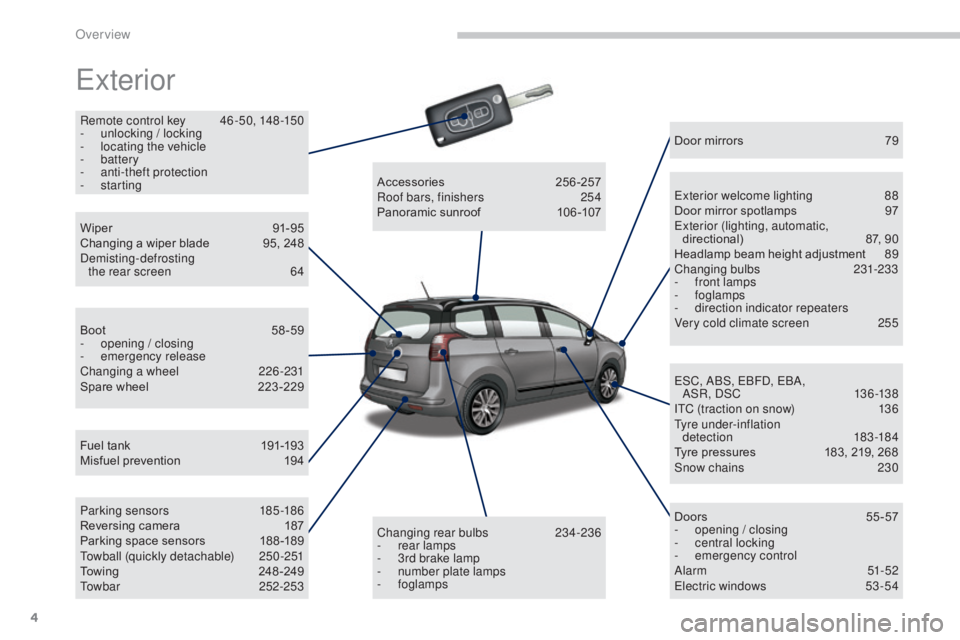
4
5008_en_Chap00b_vue-ensemble_ed01-2015
Exterior
Remote control key 46 -50, 148 -150
- u nlocking / locking
-
l
ocating the vehicle
-
battery
-
a
nti-theft protection
-
starting
Fuel tank
1
91-193
Misfuel prevention
1
94
Wiper
91
-95
Changing a wiper blade
9
5, 248
Demisting-defrosting the rear screen
6
4
Boot
5
8-59
-
ope
ning / closing
-
em
ergency release
Changing a wheel
2
26-231
Spare wheel
2
23 -229
Parking sensors
1
85-186
Reversing camera
1
87
Parking space sensors
1
88 -189
Towball (quickly detachable)
2
50 -251
Towing
24
8-249
Towbar
252-253Accessories
2
56-257
Roof bars, finishers
2
54
Panoramic sunroof
1
06 -107Door mirrors
7
9
Exterior welcome lighting
8
8
Door mirror spotlamps
9
7
Exterior (lighting, automatic, directional)
87
, 90
Headlamp beam height adjustment
8
9
Changing bulbs
2
31-233
-
f
ront lamps
-
foglamps
-
d
irection indicator repeaters
Very cold climate screen
2
55
Doors
5
5 -57
-
ope
ning / closing
-
c
entral locking
-
em
ergency control
Alarm
51-52
Electric windows
5
3 -54
ESC, ABS, EBFD, EBA,
AS R , DSC
13
6 -13 8
ITC (traction on snow)
1
36
Tyre under-inflation detection
18
3 -18 4
Tyre pressures
1
83, 219, 268
Snow chains
2
30
Changing rear bulbs
2
34-236
-
r
ear lamps
-
3
rd brake lamp
-
n
umber plate lamps
-
foglamps
Over view
Page 13 of 364
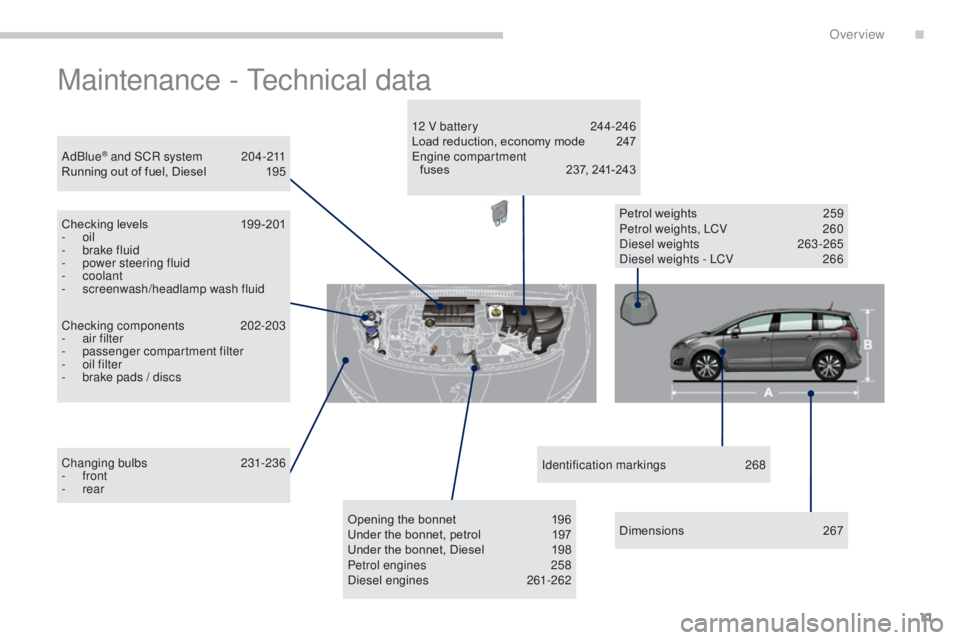
11
5008_en_Chap00b_vue-ensemble_ed01-2015
Maintenance - Technical data
Checking components 202-203
- a ir filter
-
p
assenger compartment filter
-
o
il filter
-
b
rake pads / discs
AdBlue
® and SCR system 2
04-211
Running out of fuel, Diesel 1 95
Checking levels
1
99 -201
-
oil
-
b
rake fluid
-
p
ower steering fluid
-
coolant
-
s
creenwash/headlamp wash fluid
Changing bulbs
2
31-236
-
front
-
rear Petrol weights
2
59
Petrol weights, LCV
2
60
Diesel weights
26
3-265
Diesel weights - LCV
2
66
12 V battery
2
44-246
Load reduction, economy mode 2 47
Engine compartment fuses
2 37, 241-243
Opening the bonnet
1
96
Under the bonnet, petrol
1
97
Under the bonnet, Diesel
1
98
Petrol engines
2
58
Diesel engines
2
61-262Identification markings
2
68
Dimensions
2
67
.
Over view
Page 14 of 364
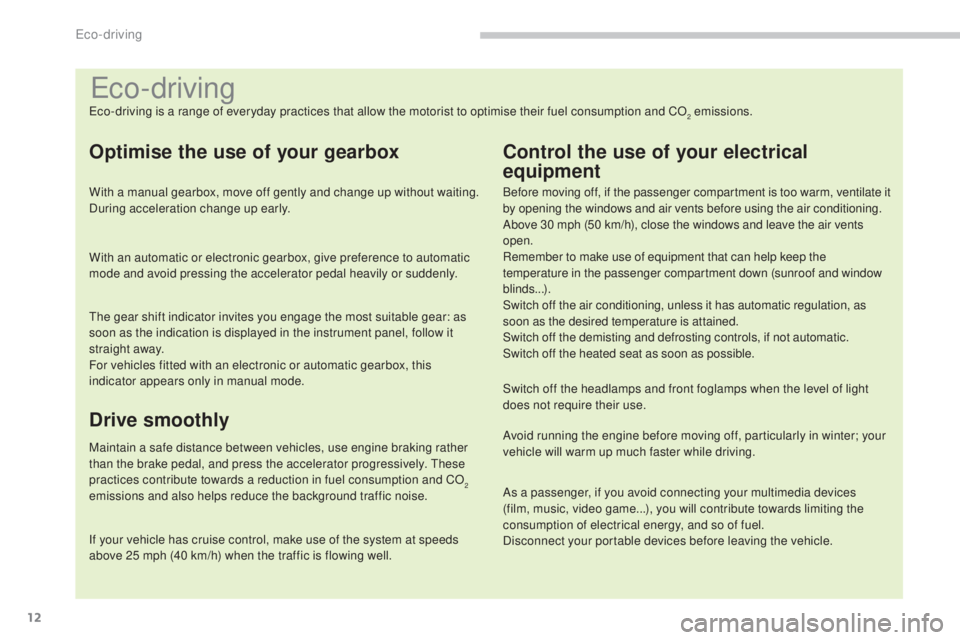
12
5008_en_Chap00c_eco-conduite_ed01-2015
Eco-driving
Eco-driving is a range of everyday practices that allow the motorist to optimise their fuel consumption and CO2 emissions.
Optimise the use of your gearbox
With a manual gearbox, move off gently and change up without waiting.
During acceleration change up early.
With an automatic or electronic gearbox, give preference to automatic
mode and avoid pressing the accelerator pedal heavily or suddenly.
The gear shift indicator invites you engage the most suitable gear: as
soon as the indication is displayed in the instrument panel, follow it
straight away.
For vehicles fitted with an electronic or automatic gearbox, this
indicator appears only in manual mode.
Drive smoothly
Maintain a safe distance between vehicles, use engine braking rather
than the brake pedal, and press the accelerator progressively. These
practices contribute towards a reduction in fuel consumption and CO
2
emissions and also helps reduce the background traffic noise.
If your vehicle has cruise control, make use of the system at speeds
above 25 mph (40 km/h) when the traffic is flowing well.
Control the use of your electrical
equipment
Before moving off, if the passenger compartment is too warm, ventilate it
by opening the windows and air vents before using the air conditioning.
Above 30 mph (50 km/h), close the windows and leave the air vents
open.
Remember to make use of equipment that can help keep the
temperature in the passenger compartment down (sunroof and window
blinds...).
Switch off the air conditioning, unless it has automatic regulation, as
soon as the desired temperature is attained.
Switch off the demisting and defrosting controls, if not automatic.
Switch off the heated seat as soon as possible.
Switch off the headlamps and front foglamps when the level of light
does not require their use.
Avoid running the engine before moving off, particularly in winter; your
vehicle will warm up much faster while driving.
As a passenger, if you avoid connecting your multimedia devices
(film, music, video game...), you will contribute towards limiting the
consumption of electrical energy, and so of fuel.
Disconnect your portable devices before leaving the vehicle.
Eco-driving
Page 15 of 364
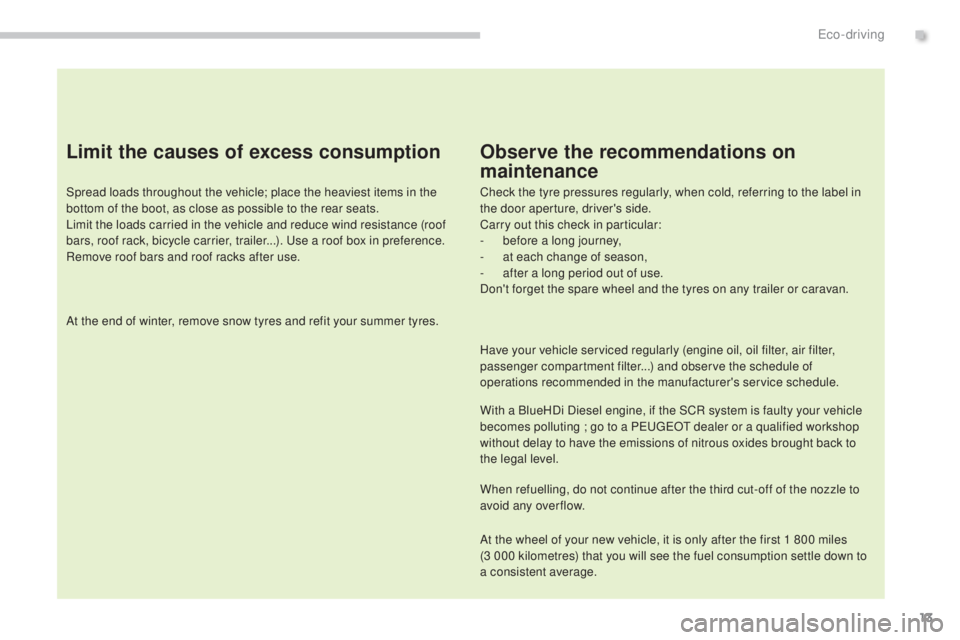
13
5008_en_Chap00c_eco-conduite_ed01-2015
Limit the causes of excess consumption
Spread loads throughout the vehicle; place the heaviest items in the
bottom of the boot, as close as possible to the rear seats.
Limit the loads carried in the vehicle and reduce wind resistance (roof
bars, roof rack, bicycle carrier, trailer...). Use a roof box in preference.
Remove roof bars and roof racks after use.
At the end of winter, remove snow tyres and refit your summer tyres.
Observe the recommendations on
maintenance
Check the tyre pressures regularly, when cold, referring to the label in
the door aperture, driver's side.
Carry out this check in particular:
-
b
efore a long journey,
-
a
t each change of season,
-
a
fter a long period out of use.
Don't forget the spare wheel and the tyres on any trailer or caravan.
Have your vehicle serviced regularly (engine oil, oil filter, air filter,
passenger compartment filter...) and observe the schedule of
operations recommended in the manufacturer's service schedule.
With a BlueHDi Diesel engine, if the SCR system is faulty your vehicle
becomes polluting ; go to a PEUGEOT dealer or a qualified workshop
without delay to have the emissions of nitrous oxides brought back to
the legal level.
When refuelling, do not continue after the third cut-off of the nozzle to
avoid any over flow.
At the wheel of your new vehicle, it is only after the first 1 800 miles
(3
000 kilometres) that you will see the fuel consumption settle down to
a consistent average.
.
Eco-driving
Page 16 of 364
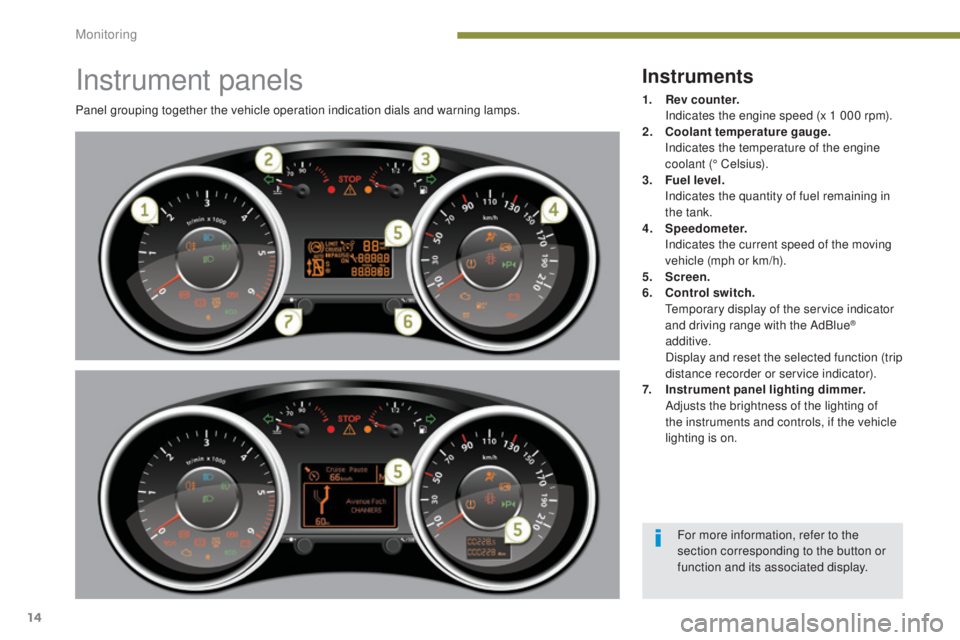
14
5008_en_Chap01_controle-marche_ed01-2015
Instrument panels
Panel grouping together the vehicle operation indication dials and warning lamps.
Instruments
1. Rev counter. I
ndicates the engine speed (x 1 000 rpm).
2.
C
oolant temperature gauge.
I
ndicates the temperature of the engine
coolant (° Celsius).
3.
F
uel level.
I
ndicates the quantity of fuel remaining in
the tank.
4.
S
peedometer.
I
ndicates the current speed of the moving
vehicle (mph or km/h).
5.
S
creen.
6.
C
ontrol switch.
T
emporary display of the service indicator
and driving range with the AdBlue
®
additive.
D
isplay and reset the selected function (trip
distance recorder or service indicator).
7.
I
nstrument panel lighting dimmer.
A
djusts the brightness of the lighting of
the instruments and controls, if the vehicle
lighting is on.
For more information, refer to the
section corresponding to the button or
function and its associated display.
Monitoring
Page 24 of 364
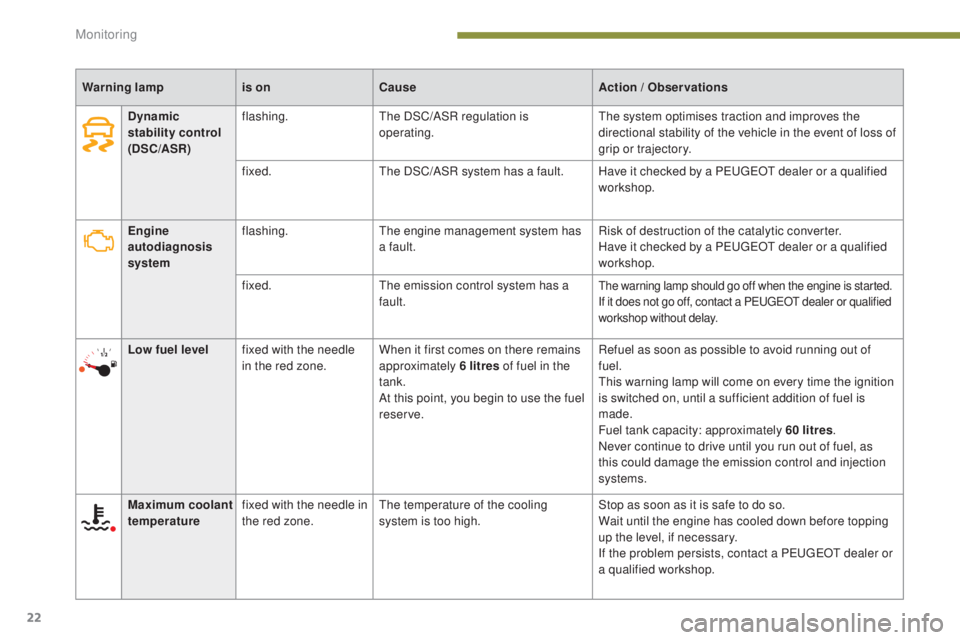
22
5008_en_Chap01_controle-marche_ed01-2015
Warning lampis onCause Action / Observations
Engine
autodiagnosis
system flashing.
The engine management system has
a fault. Risk of destruction of the catalytic converter.
Have it checked by a PEUGEOT dealer or a qualified
workshop.
fixed. The emission control system has a
fault.
The warning lamp should go off when the engine is started.
If it does not go off, contact a PEUGEOT dealer or qualified
workshop without delay.
Low fuel levelfixed with the needle
in the red zone. When it first comes on there remains
approximately 6 litres of fuel in the
tank.
At this point, you begin to use the fuel
reserve. Refuel as soon as possible to avoid running out of
fuel.
This warning lamp will come on every time the ignition
is switched on, until a sufficient addition of fuel is
made.
Fuel tank capacity: approximately 60 litres
.
Never continue to drive until you run out of fuel, as
this could damage the emission control and injection
systems.
Maximum coolant
temperature fixed with the needle in
the red zone. The temperature of the cooling
system is too high. Stop as soon as it is safe to do so.
Wait until the engine has cooled down before topping
up the level, if necessary.
If the problem persists, contact a PEUGEOT dealer or
a qualified workshop.
Dynamic
stability control
(DSC/ASR) flashing.
The DSC/ASR regulation is
operating. The system optimises traction and improves the
directional stability of the vehicle in the event of loss of
grip or trajectory.
fixed. The DSC/ASR system has a fault. Have it checked by a PEUGEOT dealer or a qualified
workshop.
Monitoring
Page 28 of 364
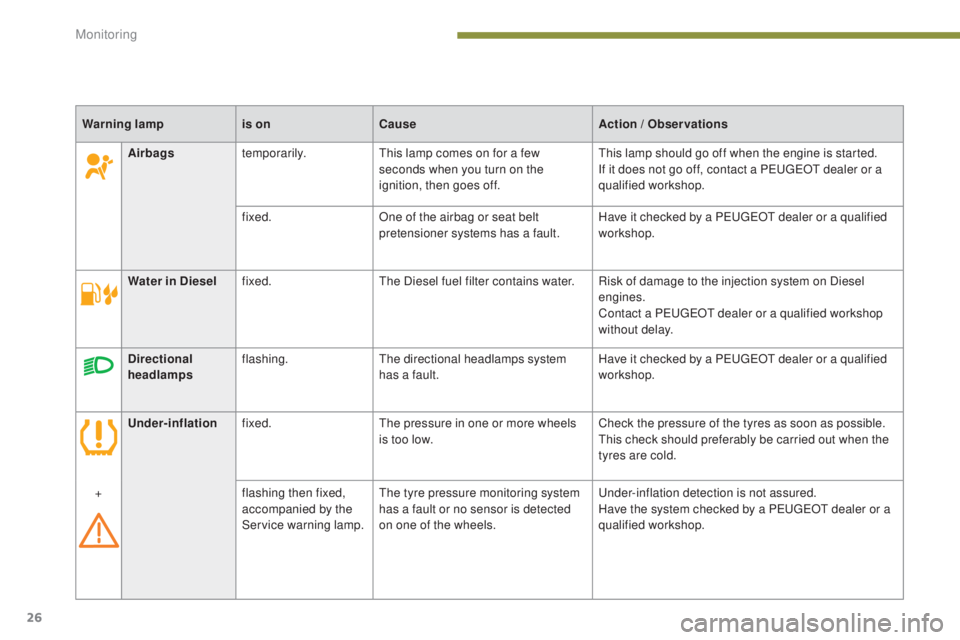
26
5008_en_Chap01_controle-marche_ed01-2015
Warning lampis onCause Action / Observations
Directional
headlamps flashing.
The directional headlamps system
has a fault. Have it checked by a PEUGEOT dealer or a qualified
workshop.
Under-inflation fixed. The pressure in one or more wheels
is too low. Check the pressure of the tyres as soon as possible.
This check should preferably be carried out when the
tyres are cold.
+ flashing then fixed,
accompanied by the
Service warning lamp.The tyre pressure monitoring system
has a fault or no sensor is detected
on one of the wheels. Under-inflation detection is not assured.
Have the system checked by a PEUGEOT dealer or a
qualified workshop.
Airbags
temporarily. This lamp comes on for a few
seconds when you turn on the
ignition, then goes off. This lamp should go off when the engine is started.
If it does not go off, contact a PEUGEOT dealer or a
qualified workshop.
fixed. One of the airbag or seat belt
pretensioner systems has a fault. Have it checked by a PEUGEOT dealer or a qualified
workshop.
Water in Diesel fixed. The Diesel fuel filter contains water. Risk of damage to the injection system on Diesel
engines.
Contact a PEUGEOT dealer or a qualified workshop
without delay.
Monitoring
Page 42 of 364
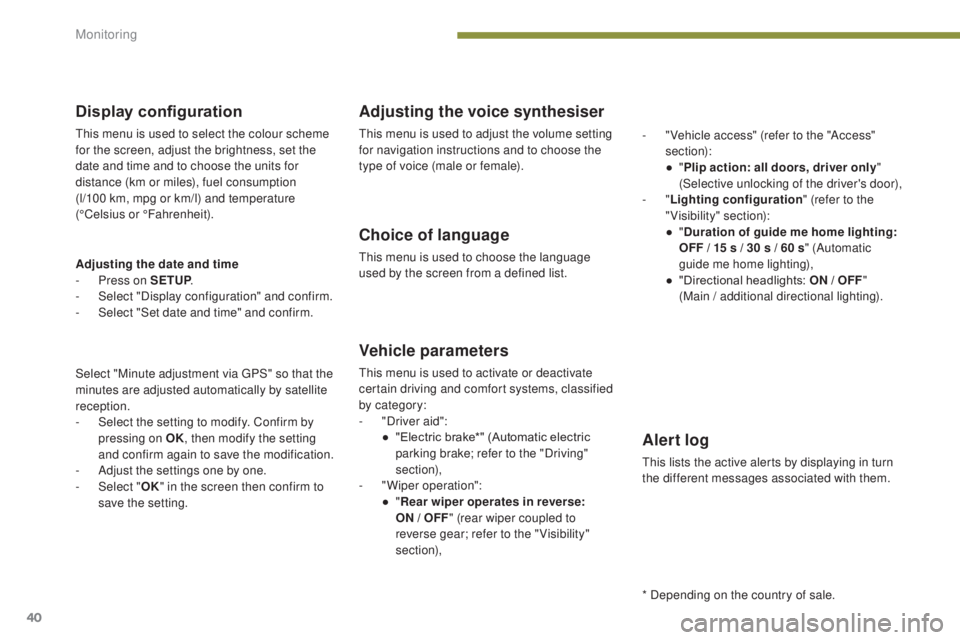
40
5008_en_Chap01_controle-marche_ed01-2015
Display configuration
This menu is used to select the colour scheme
for the screen, adjust the brightness, set the
date and time and to choose the units for
distance (km or miles), fuel consumption
(l/100 km, mpg or km/l) and temperature
(°Celsius or °Fahrenheit).
Adjusting the voice synthesiser
This menu is used to adjust the volume setting
for navigation instructions and to choose the
type of voice (male or female).
Choice of language
This menu is used to choose the language
used by the screen from a defined list.
Vehicle parameters
This menu is used to activate or deactivate
certain driving and comfort systems, classified
by category:
-
"
Driver aid":
●
"
Electric brake*" (Automatic electric
parking brake; refer to the "Driving"
section),
-
"
Wiper operation":
●
"R
ear wiper operates in reverse:
ON
/ OFF" (rear wiper coupled to
reverse gear; refer to the " Visibility"
section), -
"
Vehicle access" (refer to the "Access"
section):
●
"
P
lip action: all doors, driver only
"
(Selective unlocking of the driver's door),
- "
Lighting configuration " (refer to the
"Visibility" section):
●
"
D
uration of guide me home lighting:
OFF / 15 s / 30 s / 60 s " (Automatic
guide me home lighting),
●
"
Directional headlights: ON / OFF
"
(Main / additional directional lighting).
Alert log
This lists the active alerts by displaying in turn
the different messages associated with them.
* Depending on the country of sale.
Adjusting the date and time
-
P
ress on SETUP
.
-
Sel
ect "Display configuration" and confirm.
-
S
elect "Set date and time" and confirm.
Select "Minute adjustment via GPS" so that the
minutes are adjusted automatically by satellite
reception.
-
S
elect the setting to modify. Confirm by
pressing on OK , then modify the setting
and confirm again to save the modification.
-
A
djust the settings one by one.
-
Sel
ect " OK" in the screen then confirm to
save the setting.
Monitoring
Page 44 of 364
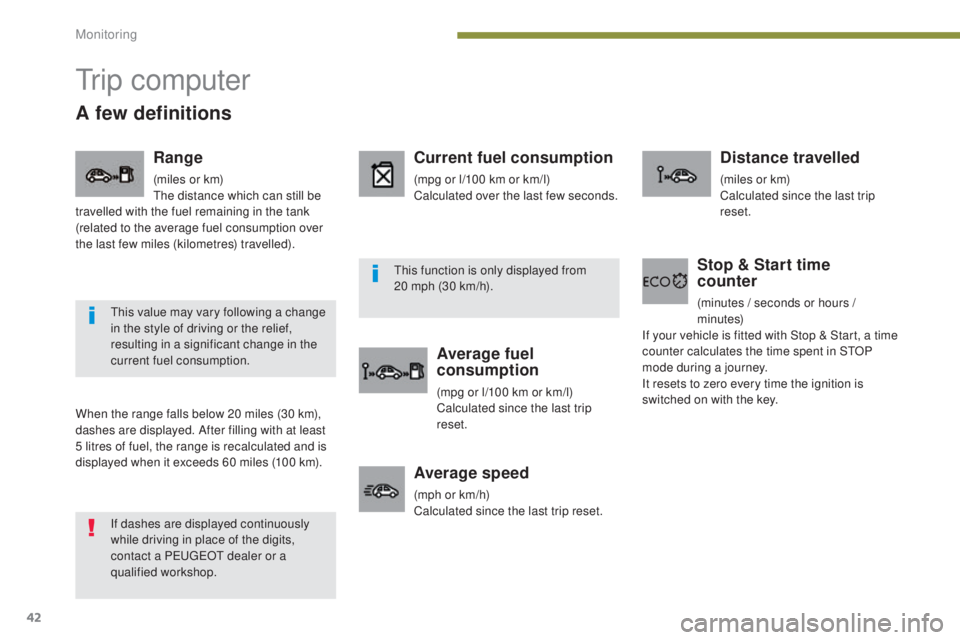
42
5008_en_Chap01_controle-marche_ed01-2015
Tr i p c o m p u t e r
When the range falls below 20 miles (30 km),
dashes are displayed. After filling with at least
5 litres of fuel, the range is recalculated and is
displayed when it exceeds 60 miles (100 km).
A few definitions
Current fuel consumption
(mpg or l/100 km or km/l)
Calculated over the last few seconds.
Average fuel
consumption
(mpg or l/100 km or km/l)
Calculated since the last trip
reset.
Distance travelled
(miles or km)
Calculated since the last trip
reset.
Average speed
(mph or km/h)
Calculated since the last trip reset.
Stop & Start time
counter
(minutes / seconds or hours /
minutes)
If your vehicle is fitted with Stop & Start, a time
counter calculates the time spent in STOP
mode during a journey.
It resets to zero every time the ignition is
switched on with the key.
If dashes are displayed continuously
while driving in place of the digits,
contact a PEUGEOT dealer or a
qualified workshop. This value may vary following a change
in the style of driving or the relief,
resulting in a significant change in the
current fuel consumption. This function is only displayed from
20 mph (30 km/h).
Range
(miles or km)
The distance which can still be
travelled with the fuel remaining in the tank
(related to the average fuel consumption over
the last few miles (kilometres) travelled).
Monitoring